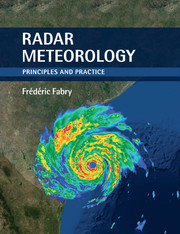Book contents
- Frontmatter
- Dedication
- Contents
- Preface
- Notation
- 1 Meteorology and radar
- 2 Fundamentals of weather radar measurements
- 3 Radar reflectivity and products
- 4 Reflectivity patterns
- 5 Doppler velocity information
- 6 The added value of dual polarization
- 7 Convective storm surveillance
- 8 Monitoring widespread systems
- 9 Radar estimation of precipitation
- 10 Nowcasting
- 11 Additional radar measurements and retrievals
- 12 Cloud and spaceborne radars
- 13 What does radar really measure?
- Appendix A Mathematics and statistics of radar meteorology
- References
- Index
1 - Meteorology and radar
Published online by Cambridge University Press: 05 June 2015
- Frontmatter
- Dedication
- Contents
- Preface
- Notation
- 1 Meteorology and radar
- 2 Fundamentals of weather radar measurements
- 3 Radar reflectivity and products
- 4 Reflectivity patterns
- 5 Doppler velocity information
- 6 The added value of dual polarization
- 7 Convective storm surveillance
- 8 Monitoring widespread systems
- 9 Radar estimation of precipitation
- 10 Nowcasting
- 11 Additional radar measurements and retrievals
- 12 Cloud and spaceborne radars
- 13 What does radar really measure?
- Appendix A Mathematics and statistics of radar meteorology
- References
- Index
Summary
If you live in an affluent country, chances are good that one or more radars dedicated to the monitoring of weather take regular measurements of the atmosphere above you. Radar has become a standard instrument in meteorology, joining the thermometer, the radiosonde, and satellite-based imagers as tools used operationally in weather offices. Its images are widely distributed and frequently consulted: in many countries, the web pages showing weather radar images are among the most frequently visited government sites. It is also a key instrument used in research to understand weather phenomena, particularly cloud and precipitation processes. It hence appears that the use of radar in meteorology is here to stay. How and why did this happen?
How it all started
The year was 1940. World War II raged. The improvement of a decade-old invention, the radar, was being stimulated by the need to detect raiding airplanes and submarines capable of sinking convoys. The radars then transmitted long radio frequency waves and received echoes that bounce off targets, allowing military personnel to detect the enemy at sufficiently long distances to be able to react to the threat. However, at that time, they were huge devices that looked much more like modern-day radio station transmitting antennas, and their angular resolution was poor. A new technological development, the magnetron, provided a solution to this problem by allowing radar to use much shorter wavelengths, microwaves, to achieve the same task; as a result, radar units could become much smaller and be easily moved and installed on aircraft. By the following year, magnetron-based radars were detecting large patches of echoes of unknown origin. It was soon realized that these echoes were caused by precipitation.
War secrecy prevented the publication of such results. Fortunately, during World War II, most meteorological services were part of the military because of the strategic use of weather forecasting. Meteorology personnel were hence shown these images, and immediately realized their potential.
- Type
- Chapter
- Information
- Radar MeteorologyPrinciples and Practice, pp. 1 - 7Publisher: Cambridge University PressPrint publication year: 2015



